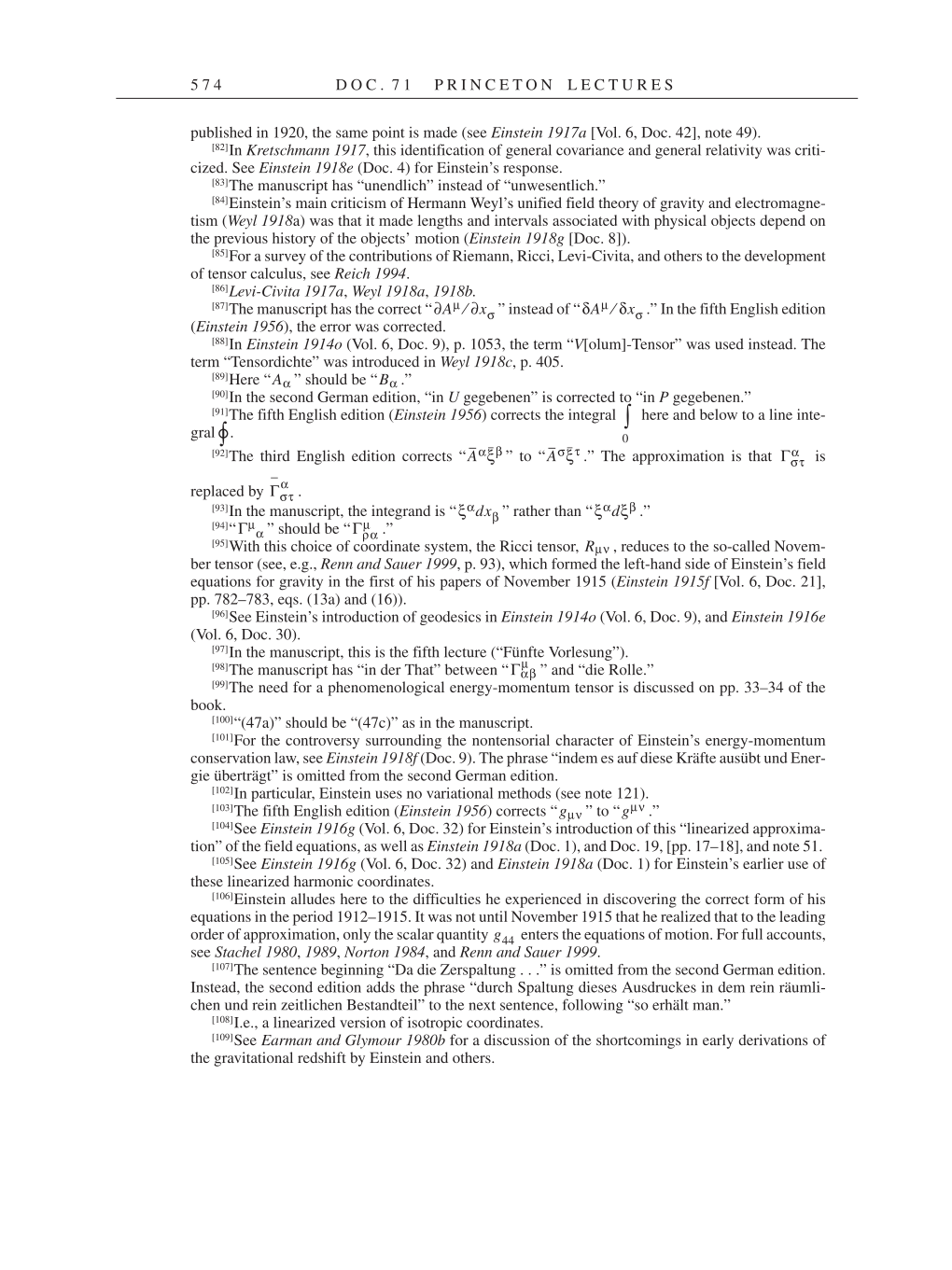5 7 4 D O C . 7 1 P R I N C E T O N L E C T U R E S
published in 1920, the same point is made (see Einstein 1917a [Vol. 6, Doc. 42], note 49).
[82]In Kretschmann 1917, this identification of general covariance and general relativity was criti-
cized. See Einstein 1918e (Doc. 4) for Einstein’s response.
[83]The manuscript has “unendlich” instead of “unwesentlich.”
[84]Einstein’s main criticism of Hermann Weyl’s unified field theory of gravity and electromagne-
tism (Weyl 1918a) was that it made lengths and intervals associated with physical objects depend on
the previous history of the objects’ motion (Einstein 1918g [Doc. 8]).
[85]For a survey of the contributions of Riemann, Ricci, Levi-Civita, and others to the development
of tensor calculus, see Reich 1994.
[86]Levi-Civita 1917a, Weyl 1918a, 1918b.
[87]The manuscript has the correct “ ” instead of “ .” In the fifth English edition
(Einstein 1956), the error was corrected.
[88]In Einstein 1914o (Vol. 6, Doc. 9), p. 1053, the term “V[olum]-Tensor” was used instead. The
term “Tensordichte” was introduced in Weyl 1918c, p. 405.
[89]Here “ ” should be “ .”
[90]In the second German edition, “in U gegebenen” is corrected to “in P gegebenen.”
[91]The fifth English edition (Einstein 1956) corrects the integral here and below to a line inte-
gral
[92]The third English edition corrects “ ” to “ .” The approximation is that is
replaced by .
[93]In the manuscript, the integrand is “ ” rather than “ .”
[94]“ ” should be “ .”
[95]With this choice of coordinate system, the Ricci tensor, , reduces to the so-called Novem-
ber tensor (see, e.g., Renn and Sauer 1999, p. 93), which formed the left-hand side of Einstein’s field
equations for gravity in the first of his papers of November 1915 (Einstein 1915f [Vol. 6, Doc. 21],
pp. 782–783, eqs. (13a) and (16)).
[96]See Einstein’s introduction of geodesics in Einstein 1914o (Vol. 6, Doc. 9), and Einstein 1916e
(Vol. 6, Doc. 30).
[97]In the manuscript, this is the fifth lecture (“Fünfte Vorlesung”).
[98]The manuscript has “in der That” between “ ” and “die Rolle.”
[99]The need for a phenomenological energy-momentum tensor is discussed on pp. 33–34 of the
book.
[100]“(47a)” should be “(47c)” as in the manuscript.
[101]For the controversy surrounding the nontensorial character of Einstein’s energy-momentum
conservation law, see Einstein 1918f (Doc. 9). The phrase “indem es auf diese Kräfte ausübt und Ener-
gie überträgt” is omitted from the second German edition.
[102]In particular, Einstein uses no variational methods (see note 121).
[103]The fifth English edition (Einstein 1956) corrects “ ” to “ .”
[104]See Einstein 1916g (Vol. 6, Doc. 32) for Einstein’s introduction of this “linearized approxima-
tion” of the field equations, as well as Einstein 1918a (Doc. 1), and Doc. 19, [pp. 17–18], and note 51.
[105]See Einstein 1916g (Vol. 6, Doc. 32) and Einstein 1918a (Doc. 1) for Einstein’s earlier use of
these linearized harmonic coordinates.
[106]Einstein alludes here to the difficulties he experienced in discovering the correct form of his
equations in the period 1912–1915. It was not until November 1915 that he realized that to the leading
order of approximation, only the scalar quantity enters the equations of motion. For full accounts,
see Stachel 1980, 1989, Norton 1984, and Renn and Sauer 1999.
[107]The sentence beginning “Da die Zerspaltung . . .” is omitted from the second German edition.
Instead, the second edition adds the phrase “durch Spaltung dieses Ausdruckes in dem rein räumli-
chen und rein zeitlichen Bestandteil” to the next sentence, following “so erhält man.”
[108]I.e., a linearized version of isotropic coordinates.
[109]See Earman and Glymour 1980b for a discussion of the shortcomings in early derivations of
the gravitational redshift by Einstein and others.
∂Aμ ∂xσ ⁄ δAμ δxσ ⁄
Aα Bα
0
∫
°.
∫
Aαξβ Aσξτ Γστ α
Γστ
α
ξαdxβ ξαdξβ
Γμα Γρα μ
Rμν
Γαβ
μ
gμν gμν
g44
